Life As A Surfer
Surfing Can Change Lives: The Jimmy Miller Foundation
SurfScience.com Introduction: We all know and love someone with physical or emotional disabilities. We also live in a world of surfing that, unless you’re careful, only focuses on 360-aerials, professional competitions, and getting sponsored. It can sometimes become easy to forget our powerful connection to the ocean and surfing’s incredible curing potential for the mind, body, and soul. Most surfers call it “stoke” but believe it or not, there is some real medical research that explains how surfing can be beneficial to those with disabilities. It’s called “Ocean Therapy”.
Here at SurfScience, we are excited to talk about an incredible surfing program that introduces Wounded Warriors (service members who were wounded in combat), and others with physical or emotional disabilities to the pure joy of the ocean and the empowerment that comes with surfing a wave.
I’ve talked with many other surfers about this interview, and it has been unanimous that the entire program is absolutely incredible.
Let’s talk to Jeff Miller- President of Jimmy Miller Foundation and Carly Rodgers PHD- the Director of the JMMF Ocean Therapy Program and learn more about the Jimmy Miller Foundation.
SurfScience.com: Let’s start with some background information. Who is Jimmy Miller?
Jeff: My brother Jimmy was a true surfer in every definition of the world. He loved the ocean, sharing it with friends and travelling the world. He was a LA County Lifeguard, Junior Lifeguard Instructor, author, pioneering world traveler and he started one of the first surf camps in Los Angeles County in Manhattan Beach. For 35 years of his life he lived a wonderful life with great friends, family and made a living from his passion of surfing and the ocean Around his 35th birthday something changed and he very quickly fell into a severe mental illness. It was magnified by the fact that he had a physical injury or a torn labrum in his shoulder that kept him out of the water for a few months. In effect, his coping mechanism was no longer available. We all looked for help and a diagnosis and saw amazing specialist in the field of mental health- depression, bipolar, mental break- but the decline was so rapid that within 6 months it went from “something is a bit off with Jim” to “we need to find help”, to “he is safe at a inpatient mental health facility” to eventually taking his own life in August of 2004.
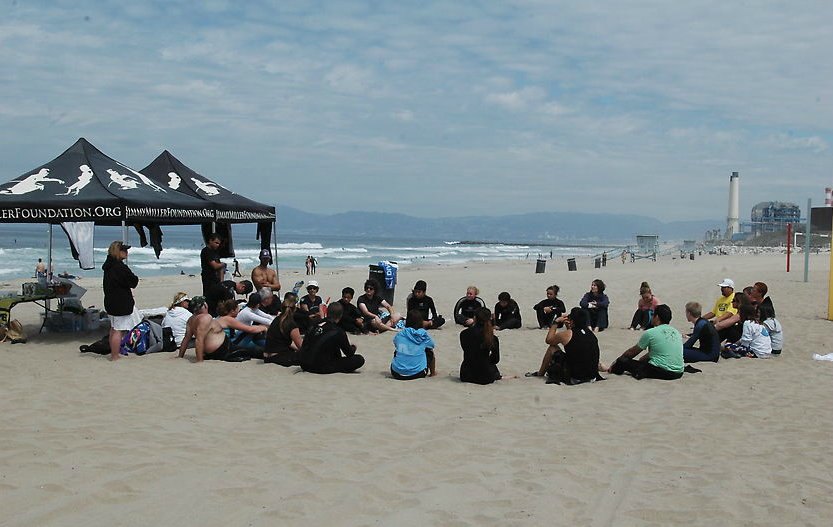
SurfScience.com: How did Jimmy’s story inspire the vision and philosphy of the Jimmy Miller Foundation?
Jeff: After Jim’s suicide there was a huge outpouring of support from friends, family, our South Bay surfing community and the many surfing friends Jim had made around the globe. We wanted to channel that energy somewhere. Jim’s passion was the ocean and teaching surfing. By fate one of our good friends, Carly Rogers was finishing her Master’s thesis at USC in Occupational Therapy about her “Ocean Therapy” program. The thesis was that through being in the ocean and specifically the activity of surfing that people suffering from mental and physical illness or injury could heal and achieve higher levels of self-efficacy. We talked about what a program could look like, put together an amazing Board of Directors to help guide us and launched the program knowing that this was a perfect fit to match Jim’s legacy.
SurfScience.com: Who is the Jimmy Miller Foundation for?
Jeff: When we first started the JMMF, the group we worked with were kids ranging in age from 6-16 who were part of the LA County Foster Care program. Most of whom were abused in some way. Specifically we started wtih am amazing group at Hollygrove (http://hollygrove.org/about/history.shtml) who we will work with every summer We then expanded to other children’s groups in Los Angeles (Richstone, Hillsides). In 2007 we expanded our Ocean Therapy program to include wounded military from the Wounded Warrior Battalion at Camp Pendleton. The Wounded Warrior Program has expanded from 1 session in 2007 to over 20 sessions in 2012.
SurfScience.com: Ocean Therapy is something really innovative you guys are working with. What exactly is the theory and practice of Ocean Therapy?
Carly: Ocean Therapy involves utilizing the challenging sport of surfing in the dynamic ocean environment to inspire increased self-efficacy in individuals coping with mental, emotional or physical challenges. By the mere success of standing up and riding a wave along with supportive volunteers, Ocean Therapy participants are able to move past their challenges and envision goals for their future.
SurfScience.com: Can you give a breakdown of what a typical day looks like?
Carly: Each Ocean Therapy group consists of 10-15 participants, 15-20 volunteers, a safety and logistics coordinator, and an occupational therapist. Our volunteers come from a wide range of backgrounds and age groups including junior lifeguards, Vietnam Veterans, Hall of Fame surfers, professional surf instructors and everything in between. Each 4-hour session consists of an introductory presentation where all JMMF participants and volunteers meet in a circle to discuss the mission of the foundation, the schedule for the day, safety precautions and ocean conditions as well as introductions where a resiliency topic is discussed. The resiliency topics range from "ways to overcome our fears" and "ways to make new friends" with the kids groups, to "sports for recovery" and "transition readiness" in Wounded Warriors and Veterans. After the resiliency topic is discussed, participants engage in a 15-minute stretch/yoga session before moving to the surfboards for 20 minutes of “on-land” instruction and practice. Participants are then paired with a surf instructor for a 45-minute individual surf lesson. This is followed by 20 minutes of discussion in which participants share the sensations and emotions evoked by the experience of surfing. Volunteers affirm the successes the participants had in the water and how they progressed through the first lesson. Participants identify a surfing skill they can improve on and then work on this skill in the second 45-minute surfing lesson. The final portion of the session includes a communal lunch, a discussion regarding skills and lessons learned and concepts acquired and usually a plan for the next surf session.
SurfScience.com: Of those people who have experienced Ocean Therapy, what do they say, what kind of changes have they experienced?
Carly: Some of the common responses from the Marines include, “This is the best day I’ve had since my injury”, “This [surfing] is curing my PTSD”, and “Surfing saved my life”. One of the most poignant responses comparing military culture to surfing culture was, "In combat, you wait and you wait and you wait and then you're fighting for your life in an intense firefight where every action could mean life or death. In surfing, you wait and you wait and then you engage in this pure natural rush with mother nature. I never knew how powerful mother nature could be".
The children's counselors and staff report that after Ocean Therapy, the kids return with a renewed sense of confidence. Some have reported that participants once shy and introverted, return to their campuses talking with peers and making friends. Some use the experience to overcome other challenges like taking a step towards learning a new sport.
SurfScience.com: What’s the difference or similarity in reaction between children that experience ocean therapy and Wounded Warriors?
Carly: We've found that for the Marines and Veterans, Ocean Therapy becomes a new family for them. Some have said the "surfing" or "JMMF family" is like a brotherhood that they felt only existed amongst their fellow servicemen. The process of engaging with the volunteers actually supports their trust with civilians and their transition to civilian life. Surfing has also been described as a catalyst, where after injury, the Marine may feel damaged or unable to complete his mission. After surfing and gaining that renewed confidence, some of the participants show a renewed vision towards the future and begin to set goals and engage with their families again.
The wounded warriors also crave the adrenaline rush and love to conquer the challenge of riding waves, especially bigger waves. The Marines have been the most incredible novice surfers our surf instructors have ever seen. Recently, a first time participant, first time surfer, was able to paddle out the back, turn the board around and catch a wave to shore at Del Mar Beach on a 2-3 ft day alone. It was incredible to watch.
The experience of the children is similar, in that their effect goes from withdrawn on the beach and shy, to smiling and cheering on their peers just after a few rides. You can visually watch their bodies relax, their trust enhanced and their confidence grow on each wave. Many of the kids say, I was scared at first and then I did my best and actually caught a wave, now I'm a surfer. It also allows them to shine in their own identity. The child's surf instructor then affirms their success while resting between sessions and you see them blush at the compliments, almost as if to say, "I can't believe I was able to do this and everyone here saw me succeed. What else can I do?"
SurfScience.com: Surfing can be challenging for any beginner. How do you approach and perform the actual surfing skills with respect to the learners.
Carly: First, we provide the participants with a lesson on land where the individual can actually see where their feet go, practice popping up a few times and are able to learn the safety precautions necessary while surfing. Next, we use at least a 1:1 ratio in the water where every surfer has their own personal surf instructor and sometimes depending on the physical injury a team of instructors.. When in the water, every beginner is supported in paddling out through the surf where the instructor helps them pop over waves. When surfing in and riding the wave, our instructors are taught to actually "ride" the back of the board which aids in stabilization of the board so the participant has ample time and stability to feel the success of riding a wave. With this process, the individual typically gets "hooked" and the instructor is then taught to slowly let go of the board as the participant gains more confidence and the skills to surf independently. We then have additional volunteers to "catch" the boards or support the surfers as they ride into shore, since we the novice surfers begin in the whitewash and typically ride all the way to the sand.
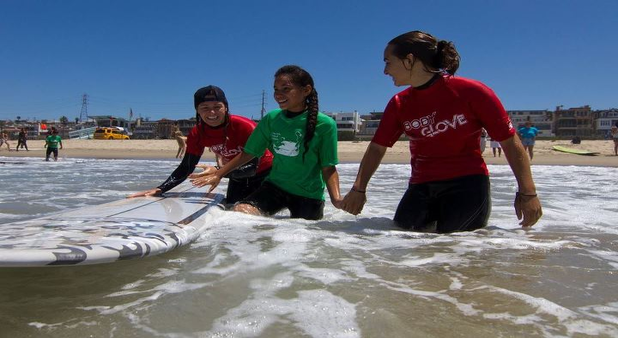
SurfScience.com: For those curious about volunteering, what advice do you have? What will volunteering involve?
Carly: The volunteers are crucial to our success. We have both "water volunteers" or surf instructors and "beach volunteers" who help with set up, break down, logistics of the day and provide a supportive environment for new participants. Both volunteer types are encouraged to share in our discussion sessions, as their life experience provides insight and inspiration to our participants. All volunteers are encouraged to get their feet wet and support the participants by cheering them on as they ride their waves.
We ask that our surf instructors have ample surfing experience, ocean knowledge and some surf instruction experience. For beginning surf instructors we help teach them Jimmy's way of teaching surfing and all of the aspects of keeping the participants safe and supported while on the board.
For beach volunteers, it may seem like most of the "action" is in the water, but much of the "therapy" at Ocean Therapy occurs on the beach. Many participants take the opportunity to chat in between surf sessions, while taking a break. Many of the Marines feel the beach and volunteers create a safe place for them to share their challenges of recovery and goals for the future. The kids may make a new friend with a younger volunteer while getting into their wet suit or talking about their waves. We are always looking for photographers, yoga instructors to lead the stretch session, and our course our beloved "beach moms" who make sure everyone has enough sunscreen and snacks throughout the day.
SurfScience.com: For those in search of the Jimmy Miller Foundation, and those interested in volunteering, who should we contact?
Jeff: It is best to go to the website for all pertinent information to get involved. Under "Calendars", volunteers can check out the schedule and pick a session to attend. It is here that they can click the desired date and sign up. We ask that they fill out a volunteer application before attending. Our volunteers are welcome to come for any duration of the session. We encourage family and friends to simply stop by and say hi, or commit to a session and become a child's first surf instructor. At Pendleton, our sessions often become a surf session, where everyone shares waves together...the Marines are that good, so bring your board! You also never know who you might get to meet while volunteering. We have plenty of surprise volunteers such as Kelly Slater, Taylor Knox, Sunny Garcia, Alex Gray, Bede Dubridge and many more professional surfers.
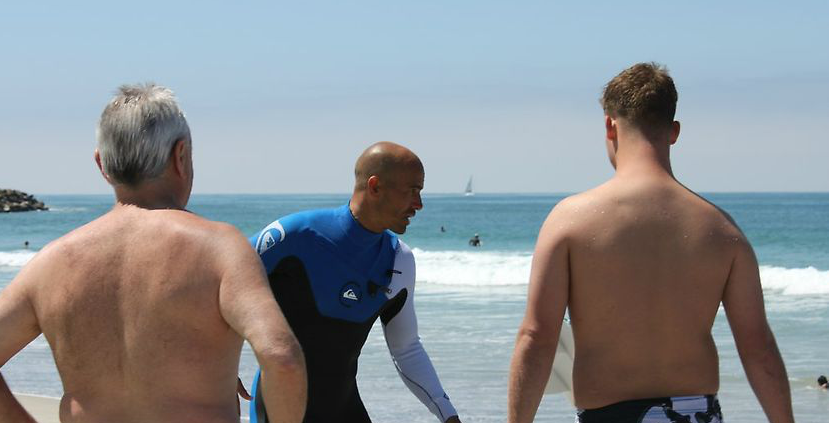
We also have a few amazing fundraising and fundraising events throughout the year including:
The Wounded Warrior Catalina Classic 32 Mile Paddleboared Relay Team in August
“The Jimmy” Surf Fiesta in October: A unique team surf event for all levels of surfing
The Surf N Turf Surf and Volleyball Invitational in May
The JMMF Benefiesta in June
and many more events throughout the year
All of us here at SurfScience.com would like to thank Jeff and Carly for their time in teaching us about Ocean Therapy and the Jimmy Miller Foundation, an incredibly positive surfing organization. If you’re interested in spending a day volunteering with the Jimmy Miller Foundation go to their website at: www.jimmymillerfoundation.org or https://www.facebook.com/jimmymillermemorialfoundation

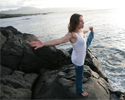
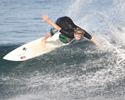



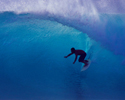
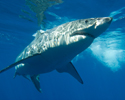

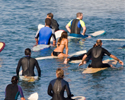
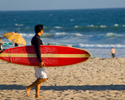
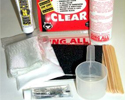



0 Comments